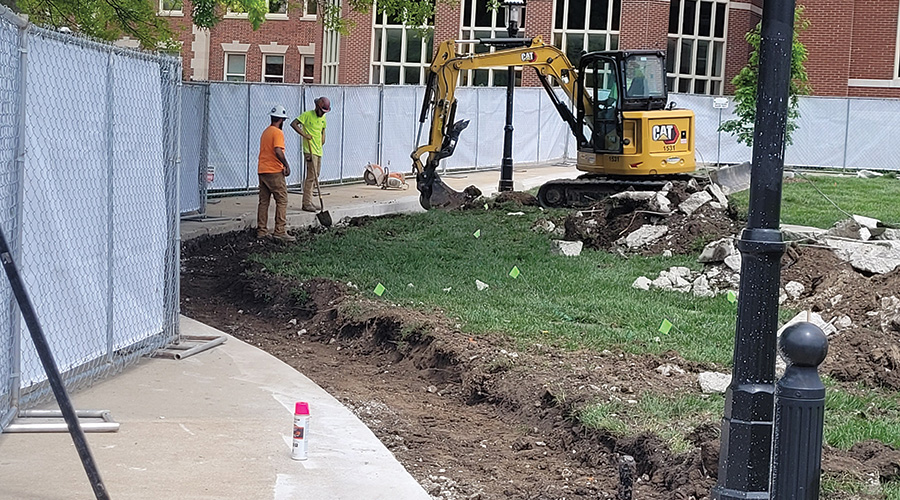Grounds Care Goes Green
From equipment specification to daily operations, environmental considerations affect every area of departments
The green movement has affected almost every area of facilities and operations in institutional and commercial organizations. But few areas have revisited and rethought the ways they do business as much as grounds care departments.
From equipment purchases to the selection of landscape materials and maintenance practices in landscaped areas, no area of grounds care has escaped scrutiny. While big-ticket equipment such as mowers and tractors tend to be the highest-profile elements of grounds operations in many institutions and attract the most attention, they are just one element in departments’ efforts to become more environmentally friendly.
“People are focusing too much on equipment,” says Kevin O’Donnell, director of grounds services with Villanova University. “They need to be more aware of the impact of operations.”
Equipment focus
While overall grounds operations will play a larger role in organizations’ green efforts, major equipment purchases nonetheless can take a great deal of managers’ time and attention. For years, the decisions on equipment specification were relatively straightforward for most managers.
“In the past, we purchased anything we wanted,” O’Donnell says. Now, as green considerations prompt manufacturers to update traditional mowers and utility vehicles and develop new, greener models, the specification is becoming more challenging and requiring more research.
“Green is not the driving force for our equipment decisions yet, but we’re asking more questions now,” O’Donnell says. “We’ve started communicating more with manufacturers, collecting information.” The department is investigating its options when it comes to such issues as fuel options for auxiliary equipment, such as golf carts.
For managers in a growing number of states, government mandates are a larger factor in their decisions.
“The governor of Arizona has mandated that gas-powered equipment no longer be used on state owned property for landscape maintenance,” says Ellen Newell, assistant director of grounds services with Arizona State University. Makers of grounds care equipment are retooling their product lines to meet these demands from the marketplace, but the process will take time.
“It became apparent the industry was not to that point yet, but blowers have been totally banned, and new purchases should be propane, electric, solar, or alternative fuel, if at all possible,” Newell says. “We are in the process of purchasing several solar golf carts for our operation. We have ‘trialed’ several propane mowers for our next mower purchase.
“The guys loved them. They mowed real well for us.” The department also will work with a student class this coming semester on retrofitting one of the department’s existing mowers to be run on hydrogen, she says.
Despite the apparent gap between the demand for green grounds care equipment and the current supply, Newell says manufacturers are becoming more sympathetic to the green needs of commercial customers.
“They all know it’s on the horizon, that we’re going to have to go that way,” she says.
O’Donnell stresses that new purchases need not be managers’ sole focus in making environmental friendly decisions that also save money.
“Equipment can be run more efficiently and sized properly to more efficiently use personnel and resources,” he says. Managers also can change the bad habits of equipment operators, he adds. For instance, they can require that drivers shut off engines when equipment is parked, instead of leaving it running with the radio on and producing air pollution.
Eye on operations
Because of the complexity of grounds operations departments and their impact on both facility operations and the environment, managers’ decisions on green issues extend well beyond equipment. Many managers are rethinking the most basic components of landscapes and the way their departments care for them.
For example, O’Donnell says his department is taking a new look at the Villanova campus and rethinking some very basic assumptions, such as determining the role of mowing. Also, O’Donnell asks, “Do we really need expansive lawns” used primarily by students for recreation? The campus’ traffic islands also have come under scrutiny and gone through a transition.
Previously, they were just lawn areas that required mowing with line trimmers and push mowers, he says. Now, they have been turned into planted areas featuring native grasses and flowers instead of turf. The change benefits the environment, but the advantages go further.
“As these landscapes mature, the need for all types of maintenance decreases substantially,” O’Donnell says. “There are significant cost savings over the long haul.” The cost of mowing such areas 30 times a year is much higher than the cost of maintaining perennials two to three times a year, he says.
And while the initial investment to make such changes can be high — removing existing turf, preparing the soil, purchasing new plants, etc. — O’Donnell says the payback on the initial investment is less than five years.
The revamped approach also has led to a reduction in the amount of chemicals the department uses on its landscaped areas. While turf areas now might have a few more weeds as a result, students seem to understand the trade-off.
“People on campus are accepting of that,” he says. Previously, if turf areas had more than even a few weeds, the department would get questions.
“Now, we get questions if they see us applying chemicals,” he says.
The beat goes on
As water shortages persist, energy prices continue to rise, and interest grows in curtailing the impact of facilities and grounds on the environment, managers seem likely to face even more changes in the way they purchase products and carry out daily operation.
“My assumption is restrictions for air quality, water conservation, and fuel use will continue, so we are always looking for alternatives so we will be ready when the requirements change,” Newell says, adding that the efforts are going on throughout the organization. For example, the university has mandated all new buildings be certified by the Leadership in Energy and Environmental Design program, and it has pilot programs for setting up effective solar photovoltaic electric generating systems, she says.
Among the emerging issues for managers is staying ahead of the changes, rather than simply responding to directives.
“We’re getting support from our administration, in large part because we’re willing to do these things,” Newell says. “It’s easier to be in control of something than to be told what to do.”
Managers also will need to incorporate new green strategies into front-line workers’ duties and attitudes as smoothly as possible.
“The message we’re sending to our crews is that this is a good thing,” Newell says, and the message seems to be sinking in. “The staff feels like they own the process. They feel like they’re being progressive.”
Related Topics:











